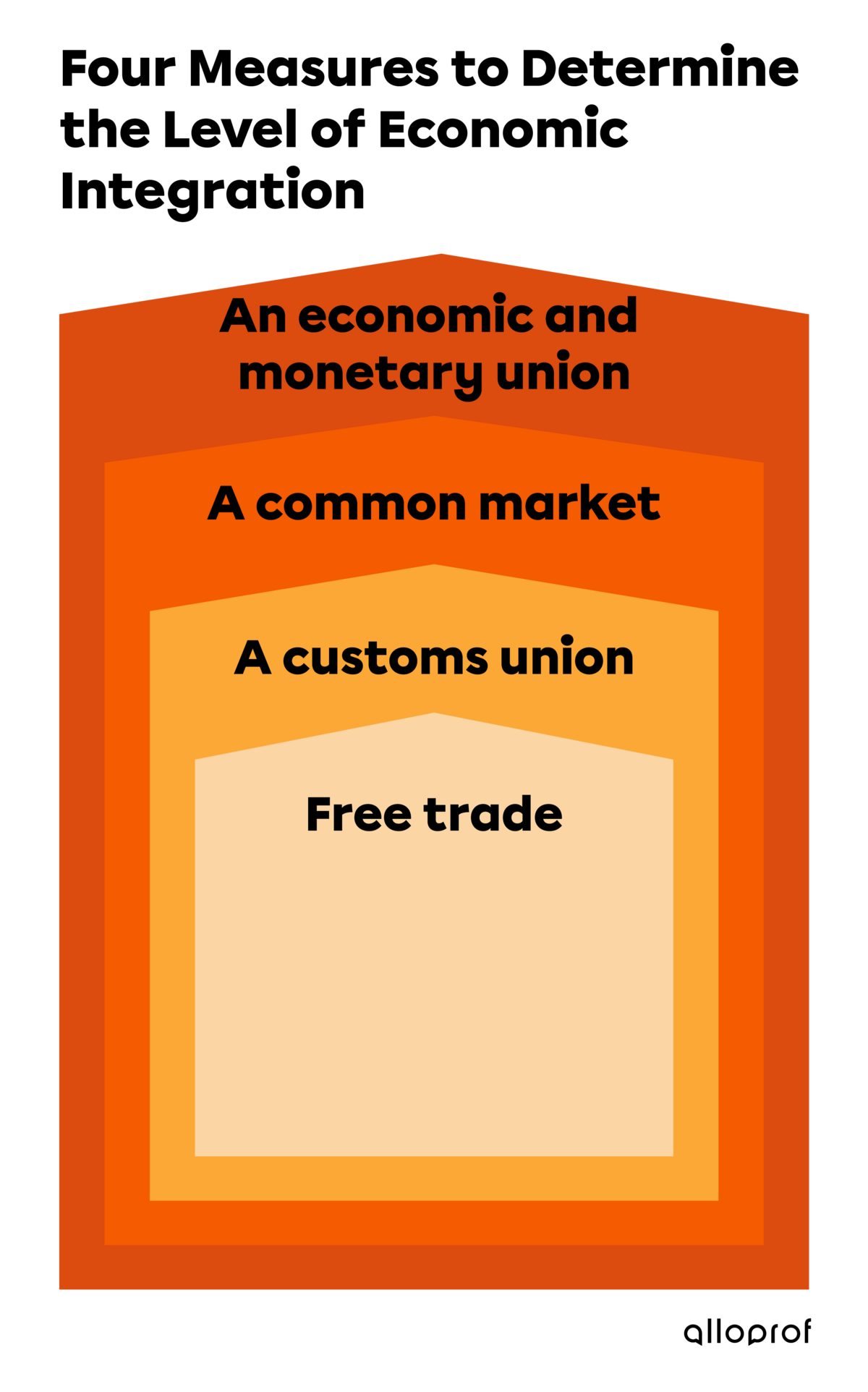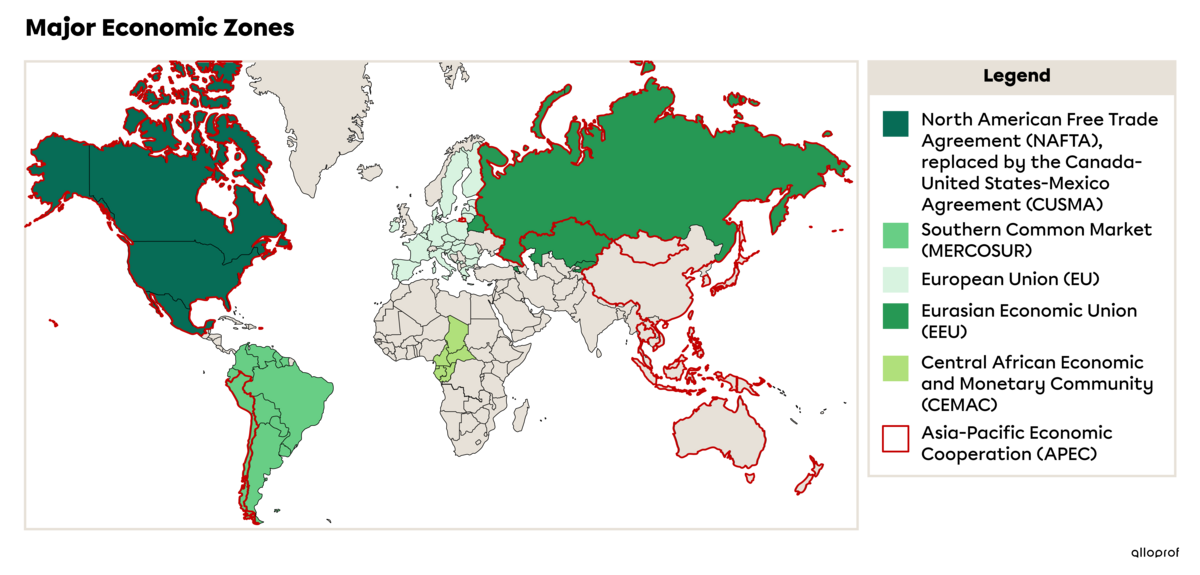Globalization has opened up markets around the world. It encourages competition between countries that offer the same product. These countries compete with each other to sell the same product to the same buyers in the same market. By being able to choose who to trade with, countries primarily look for the best prices. This is why several states have signed free trade agreements. These agreements provide them with a market to sell their products without too much competition.
-
Free trade is an economic policy that seeks to eliminate all trade barriers between states that have signed an agreement.
-
The market is a place of exchange where commercial activities take place. This is a meeting place for sellers (supply) who have a good or a service to sell and buyers (demand) who want to pay money for a product.
There are regional (Quebec), national (Canada), continental (North America) and international (global) markets.
For economic reasons, several states in the same region believe it is advantageous to join forces by signing free trade agreements. States sign these agreements in order to remove barriers and increase trade between them. Two main barriers must be removed to facilitate free trade.
The first barrier is customs tariffs. These tariffs are a tax levied on goods that cross a country’s borders. Tariffs can significantly increase the price of a product.
|
Country |
Product price* |
Customs tariff* |
Price |
Profit |
Price paid by US customers |
|---|---|---|---|---|---|
|
Canada |
$125 |
0% |
$125 |
+10% profit on sale |
$137.50 |
|
Brazil |
$110 |
15% |
$126.50 |
$139.15 |
*Fictional data
In this example, Canada does not have to pay a tariff because it has a free trade agreement with the US. Although its product is more expensive than Brazil’s product, it ends up being less expensive because there are no customs tariffs. Removing the tariff gives Canada a trade advantage, which promotes trade.
The second barrier to trade that must be removed is government subsidies to companies. To have real free trade, the government should intervene as little as possible in trade. This is called laissez-faire. If a government gives subsidies to some companies, this becomes unfair to other companies in the same industry. With these government subsidies, a company could more easily lower its prices. With lower prices, this company could sell more goods and make more profit. This is considered unfair by the trading partners in a free trade agreement. If a government decides to subsidize a company anyway, it can face severe economic sanctions.
As of January 2020, there were 303 regional trade agreements. Each of these agreements involves a greater or lesser degree of economic integration based on four measures. Adopting one or more measures determines the level of economic integration between the signatory states. These measures are described below according to their level of integration, from least integrated to most integrated.
Economic integration refers to common economic policies adopted by all member states, such as tariffs, free movement of workers, goods, services and capital and the adoption of a common currency. The level of economic integration is determined by the number of common policies adopted, as well as their scope.

First is the adoption of free trade, which facilitates the exchange of goods, services and investments (capital) without tariffs between members of the agreement.
-
North American Free Trade Agreement (NAFTA), replaced by the Canada-United States-Mexico Agreement (CUSMA) on July 1, 2020
-
Comprehensive and Progressive Agreement for Trans-Pacific Partnership (CPTPP).
Next, in addition to having no tariffs between them, states can create a customs union. This means that all the signatory states apply the same tariff on imports from non-member countries.
-
Southern African Customs Union (SACU)
-
Eurasian Economic Union (EEU)
Next is the establishment of a common market. This involves a free trade agreement, a customs union and the free movement of people and services. People often move between member countries for work. Paraguayan workers can work in a Brazilian, Uruguayan or Argentinean company without going through customs. They can move freely between countries.
-
Southern Common Market (MERCOSUR)
-
Gulf Common Market
-
Common Market for Eastern and Southern Africa (COMESA)
Finally, once free trade, a customs union and a common market have been established, the last measure to promote economic integration is the adoption of an economic union. All signatory states unify their economic policies to form a large zone with the same economic rules. Some economic unions even share a common currency, such as the European Union which has the euro and the Economic Community of Central African States (CEMAC) which has the CFA franc. Having a common currency between several countries is the highest level of economic integration.
-
European Union (EU)
-
Central African Economic and Monetary Community (CEMAC)
Economic integration has several levels that are reached in a specific order. The order of each level cannot be changed. This means that a common market (3rd measure) cannot be established between several countries without first establishing free trade (1st measure) and a customs union (2nd measure).
Economic integration brings several benefits to the signatory states, but the higher the level of integration, the less sovereignty a country has. When a state applies common laws with other states, it no longer makes its own laws, which limits its sovereignty to varying degrees. For example, a free trade agreement does not limit sovereignty as much as an economic union, which requires member states to adopt several common laws.
Sovereignty is the absolute power of a state to govern itself by making its own laws and enforcing them within its territory. A sovereign state is independent, meaning that it cannot be controlled by any other state or institution.
To better understand what sovereignty is, you can watch the video Sovereignty and Interference.
Economic forums are not economic integration. While they also aim to increase trade between countries, these countries retain their full sovereignty. Members discuss strategies to achieve their goals without making joint decisions. Participating states do not have to make any commitments.
-
Asia-Pacific Economic Cooperation (APEC)
-
International Economic Forum of the Americas (IEFA)
|
Agreement |
Member countries |
|---|---|
|
North American Free Trade Agreement (NAFTA), replaced by CUSMA |
Canada, USA and Mexico (3 states) |
|
Eurasian Economic Union (EEU) |
Armenia, Belarus, Kazakhstan, Kyrgyzstan, Russia (5 states) |
|
Southern Common Market (MERCOSUR) |
Permanent members: Argentina, Brazil, Paraguay, Uruguay and Venezuela (suspended) (5 states) Associate members: Chile, Bolivia, Peru, Colombia, Ecuador, Guyana and Suriname (7 states) |
|
European Union (EU) |
Germany, Austria, Belgium, Bulgaria, Cyprus, Croatia, Denmark, Spain, Estonia, Finland, France, Greece, Hungary, Ireland, Italy, Latvia, Lithuania, Luxembourg, Malta, the Netherlands, Poland, Portugal, Czech Republic (Czechia), Romania, Slovakia, Slovenia and Sweden (27 states) |
|
Central African Economic and Monetary Community (CEMAC) |
Cameroon, Central African Republic, Chad, Congo, Gabon and Equatorial Guinea (6 states) |
|
Asia-Pacific Economic Cooperation (APEC) |
Australia, Brunei, Canada, Chile, China, South Korea, the United States, Hong Kong (China), Indonesia, Japan, Malaysia, Mexico, New Zealand, Papua New Guinea, Peru, Philippines, Russia, Singapore, Taiwan, Thailand and Vietnam (21 states) |

Ladouceur, Maude and Alain Parent. Globe. Cahier d’apprentissage, 2014, p. 127-129.